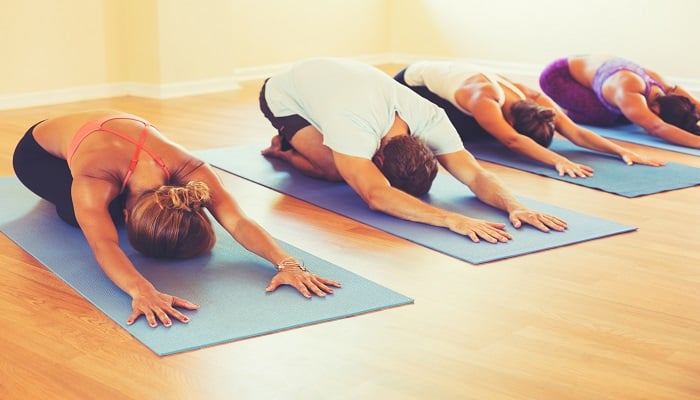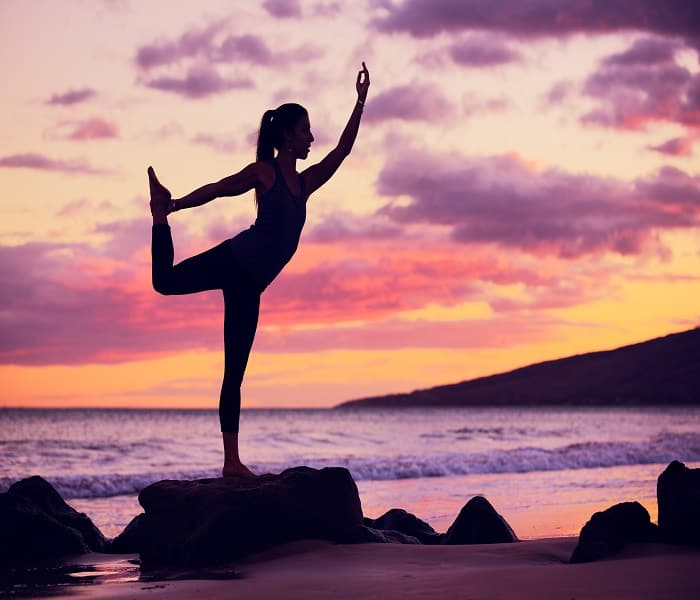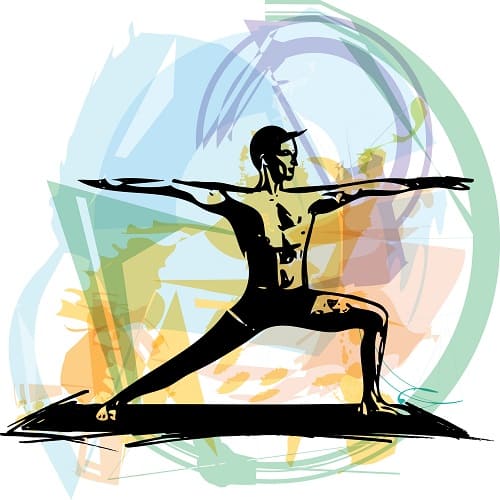
Yoga has seen an incredible increase in participants in the last decades. In fact, in some cities it’s hard to walk down the street without passing in front of a yoga studio.
What used to be a fringe practice has blossomed into the forerunner of the wellness movement and with more and more people prioritizing health and well-being, ever increasing numbers of people are walking into their very first yoga class.
If you’ve been lucky enough to find your yoga community, whether it’s online or in person or whether it’s Hot Yoga, Vinyasa Flow, Ashtanga, Iyengar, Jivamukti, Restorative or any other niche, then, congratulations, you’re on the road to better health.
Yoga undoubtably provides many benefits to the body, from balancing hormones to oxygenating the cells to optimizing the functioning of the body’s organs and systems as well as building strength and flexibility, not to mention improving mood and well-being.
But, you may be wondering, in order to reap all of these benefits, how many times a week should you do yoga?
The answer is: it depends. The amount of yoga you should do each week or in a day really depends on your state of health, your goals and the type of yoga you practice. Read on to discover more.
Beginners
Let’s say you’re just starting your yoga practice. Unless you’ve done some stretching or you’re a trained dancer or just naturally flexible, you might have difficulty doing poses like Standing Forward Fold where you bend forward and touch your toes.
Downward Dog might feel like a torture and forget about Plank and chaturangas. Don’t become discouraged! It’s really common among beginners to struggle with certain poses as you build strength, balance and flexibility.
That’s why it’s best if you build your practice slowly over time by starting with practicing twice a week with a certified yoga teacher. A good teacher can offer modifications to help you build your practice safely.
Many beginners who are bit by the yoga bug want to dive right in and start practicing every day. But, by doing this, you run the risk of pushing your limits too far too soon, potentially resulting in injury.
Flexibility and strength can’t be acquired overnight, they take patience and persistence. Additionally, alignment is key to practicing yoga safely, and it takes time, and guidance from a trained teacher to learn how to properly align in each pose and how to safely transition from one pose to the next.
Beginners, take your time learning this practice so you’ll be able to reap all the benefits it has to offer.
Intermediate
Okay, you’ve done a few months of beginner classes, mastered many of the alignment cues, no longer see Downward Dog as a form of torture and can actually do a few chaturangas without just wanting to push back into Child pose for the rest of the class. You feel like you’re ready to turn up the heat a bit.
As you transition from beginner to intermediate, again, take things slowly. Take three classes a week for a while. You’ll soon notice your strength and flexibility increasing with this extra weekly practice.
As you build stamina, remember to stay with the breath, keep checking your alignment and don’t push past your edge. The key to building a safe practice is taking things one step at a time and learning to be fully present in each moment of your practice.
As you’ll hopefully learn from your instructor, Yoga isn’t about rushing to become the best in the class, or comparing yourself to your neighbor on the mat next to you. It’s about connecting with your body, listening to and honoring its messages and learning where to find your edge and when to back off.

Advanced
Advanced yogis with strong practices generally practice every day and sometimes more than once a day. These are yogis with at least two years of consistent practice with a trained instructor.
Certain lineages of yoga, such as Ashtanga, for example, were made to be practiced every day due to its challenging nature. Ashtanga’s First Series is a rigorous 90-minute practice that goes through the same sequence of poses.
Once the yogi has mastered the First Series and are granted permission by a senior Asthanga practitioner, they can move on to the Second Series and so forth until they complete all six series (a very rare accomplishment, even among advanced practitioners).
The idea is that the yogi will master each of the levels through dedication and daily practice. (The exception to daily practices for Ashtangis is during the full and new moon phases, when practitioners traditionally abstain from practicing.)
Advanced students of other practices such as Vinyasa Flow and Iyengar also tend to have daily practices, however the postures and series will vary.
Just as not every runner is a marathoner, not everyone will become an advanced yogi. If your goal is to be healthy, to gain more strength and flexibility, then a beginner’s or intermediate practice can help you achieve that.
You don’t need to do Scorpion pose or put your legs behind your head to reap the benefits of Yoga.
While becoming an advanced yogi is an appropriate goal for some people, it may not be what you’re aiming for. Know what your goals are in Yoga so you can determine the frequency and intensity of your practice.
Remember that at an advanced level, it’s just as easy to injure yourself as it was at a beginner or intermediate level. In fact, as the yogi advances, they’ll take on more challenging postures which means the risk of injury is still present, even if the body is stronger and more flexible.
Injured students
If you have a pre-existing injury or health condition or if you injured yourself in a Yoga class, it’s important to communicate this to your instructor so they can offer modifications. Otherwise, you run the risk of aggravating your injury.
Depending on your injury, you may want to scale back the number of practices you’re doing each week. Or you might consider switching out some of your regular practices for a different style that will help promote healing.
Hot Yoga has become very popular in the U.S. and is particularly popular among athletes with injuries because the room is heated to 80-100 degrees. The purpose of this is to heat the muscles through the room’s temperature, essentially replacing the need for the muscles to “warm up,” and therefore reducing risk of injury and promoting greater flexibility in the poses.
However, be sure to check with your doctor before starting a Hot Yoga practice. It’s contraindicated for acute joint injuries and for other health conditions such as high and low blood pressure due to the high temperature in the room.
Restorative Yoga is another form of Yoga that can be beneficial for people with injuries or health conditions and can safely be practiced every day. Restorative Yoga is unique in the sense that you won’t use muscular force to enter into the poses. Instead, you’ll use yoga props such as bolsters, blankets, straps and yoga blocks to support your body in a pose, allowing for a state of deep relaxation and restoration.
This is a therapeutic practice that includes elements such as reduced lighting, a warm and inviting ambiance and sometimes soft music to promote the process of relaxation and healing.
Additionally, Restorative Yoga is a great complement to a more vigorous practice such as Ashtanga or Vinyasa Flow or Iyengar as it gives the body a chance to actively rest and recuperate. Instead of taking a day off, try adding a Restorative class once or twice a week and see how this can reenergize your regular practice.
Yoga Lifestyle
While its roots are in India, Yoga is literally everywhere today. And if you can’t find a Yoga studio in your town, you’ll certainly be able to find classes online.
The world of Yoga offers a lot of resources, courses and retreats to practitioners. If you take a course or go on a yoga retreat, you will likely be practicing more than once a day for its duration.
If you want to deepen your practice, these courses and retreats can be very enriching. Likewise, there are online courses that offer daily yoga classes and yoga challenges to strengthen your practice and commitment.
Whatever level you’re at, whatever your access whether online or in person, enjoy the challenge of these experiences but be sure to respect your limits and rest when you need to.
Women and Yoga
This is a controversial subject that has raised a lot of questions in recent years. Traditionally in Yoga, women abstain from practicing during the first three days of their menstrual cycle. While many women today practice while menstruating, teachers will often advise them not to practice inversions or deep twists.
While there’s evidence supporting either side of the matter, in the end, if you’re a woman practicing Yoga, use the practice as a way to connect with and listen to your body. If you feel okay practicing and doing inversions and twists while menstruating, it’s your body and your practice.
Likewise, for pregnant women with strong practices, they’re usually advised to avoid certain postures after the first trimester. Today, there are many prenatal and postnatal Yoga classes available with trained instructors who can offer you guidance on having a safe practice before and after your pregnancy. It’s generally suggested that women take pre- and post-natal classes up to three times a week.

Honor Your Body
There are days when you will be brimming with energy and days when you’re tired and just want to make it to Savasana. Though many practitioners love Yoga precisely because it’s a respite from the rest of life, the ups and downs of everyday life will follow you to your class.
If you got little sleep, if you’re stressed at home or work or if you’re well-rested and taking good care of yourself, it will show when you come to the mat. There may be weeks when you need to take less classes or take a more relaxing class or learn how to tone it down in your regular practice by doing modifications on the days when your energy is low.
As with all physical activities, you will get the most out of Yoga by learning how to listen to your body and take a break when you need it. Make your health a true priority and enjoy your yoga practice.
You may also be interested in:
1. Ashtanga vs Vinyasa [What’s the Difference Between These Two Yoga Styles]
2. Is Yoga Enough to Stay Fit?
3. How to Use the Raikov Effect
4. Positive Affirmations For Mental Health



